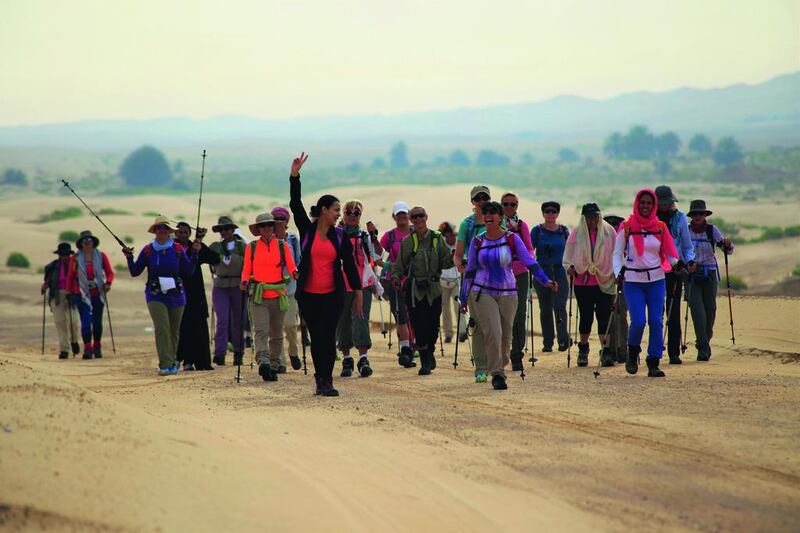On International Women's Day, 23 expat and 21 Emirati women embarked on a 120-kilometre walk across the dunes from Al Ain to Abu Dhabi. For the expats, the Women's Heritage Walk was a chance to get a deeper understanding of the UAE's Bedouin customs, for their evenings would be filled with traditional storytelling, henna painting and astronomy teachings while sitting around an open fire. For the Emiratis, the walk last month was a quest to follow in the footsteps of their ancestors and to honour their memories. For everyone, it was a chance to get to know each other a little better and be more active.
Emirati Najat Al Sayed, 56, who owns Elyazia Beauty Center in Dubai, was doing the walk in honour of her 81-year-old mother, Elyazia Al Sayed Abdulraheem, who used to do the same journey from Al Ain to Abu Dhabi regularly when she was a child. Back in those days, the most dire need was for water. "My mother told me how sometimes they would dig a hole in the ground for drinking water, using their sheilas as a filter against impurities," says Al Sayed. "Even now, my mother has so much respect for water and is very conscious of not wasting it."
The walk, which was scheduled to run over five days, could not be undertaken lightly and so weekly training sessions — at Jebel Ali conservation beach, Saadiyat Island public beach and in the desert — were organised for the women in the six months leading up to the event. The sessions allowed the women to improve their fitness and stamina, but also enabled them to get accustomed to sandy terrain.
"This journey is very doable for any woman," says American Jody Ballard, founder of Women's Heritage Walk and a licenced clinical counsellor. "But a minimum of three months training is critical, because this is life-changing, as it was for women in the past."
They set out on March 8 at 5am from Al Bada Resort in Al Ain into the desert. The first 20km went according to plan. "The air was fresh and beautiful; we loved it," says the group's photographer, Marie Jegaden, 51, from France.
But then a fierce wind started blowing sand into the women's clothes, faces, and even past their sunglasses and into their eyes. At 3pm, the rain started coming down. Some of the Emirati women danced for joy, imagining the thrill their ancestors would have felt on experiencing the downpour on their long desert journeys. "Actually, I was thinking of my mother the whole time," says Al Sayed. "I was imagining her as a kid when she was travelling through the desert, and what a blessing the rain would have been to her. Even now, whenever it rains it is always a blessing to her, no matter how much damage it does, because water is life. It was so beautiful for me to walk in that storm. Our feet felt as if we were walking through a swimming pool. It was majestic."
But the joy was short-lived. Only about a third of the walkers had raincoats with them, and after about 30 minutes, the whole group was drenched. When Ballard saw the first jolt of lightning strike the dunes nearby, she started to fear for the group's safety, as the walkers were carrying metal walking poles, which could conduct electricity. "At one point we had hail falling onto us horizontally," she says. "The storm was unprecedented, and the walk became a challenge in ways that we had never anticipated."
Ballard arranged for cars to take them to the next scheduled campsite five kilometres away, but when they arrived they found their tents were soaked through and unfit for sleeping in, so they were driven back to Al Bada Resort.
Taking in the sights
The theme of the walk was "heritage" and that became the focus for the next two days, until it was deemed safe to walk in the desert again. A trip to Al Ain Museum was organised, as well as a drive up Jebel Hafeet.
When the walk started again on the morning of Friday, March 11, the women were determined to make up for lost time and managed to trek 37km in one day.
Along the way they saw the desert coming to life after the rains. "To see the vibrant greenness of the plants filled with water was so pleasant," says Ballard. "The sand was harder because it was wet, so we were able to trek to the top of the dunes to breathe in the fresh air and look over the vista, which was absolutely magnificent. The morning clouds covered us from the sun. In many ways, the storm was a blessing."
Ballard acknowledges that not being able to walk the entire 120km because of the weather (in the end, they walked about 100km over three days), was a bit of a disappointment, but also that the trip was about more than covering a certain distance. "I had responsibility for people's safety, and sometimes I'd get het up in the details of things," she says. "The best moments for me were watching the friendships grow between the Emirati ladies and the 11 other nationalities. I also loved it when the ladies came to tell me why they were walking. When I heard their stories, I'd remember why I organised this walk in the first place."
Ups and downs
A highlight for Al Sayed was when they stumbled across a horse race in the middle of the desert. "It was magical to see them there on their horses in the dunes, and I think they were quite shocked to see us, too. There was one lady rider, so I was cheering her on."
Jegaden found herself preoccupied by her physical condition. "My focus was on tending to aching feet, eating enough protein, and drinking enough water," she says. "We all took hydrating tablets in our CamelBaks in the mornings and the afternoons, so we would not lose too much in minerals." To make sure they were well-hydrated and nourished, supplies were kept in the two cars that trailed the walkers throughout the journey. The women brought their own snacks, consisting mostly of dates, nuts and energy bars, and feasted on nutritious meals high in protein and energy. Oatmeal was on offer for breakfast, to boost energy supplies for the day.
And while their nutritional needs were met, there were some physical casualties. Jegaden recalls the "disastrous" state of some of the women's feet on the final day. "Many ladies had their feet wrapped in bandages. Some lost their nails, because of the sand going into their shoes, and others had several blisters."
The women arrived at their final destination, the Zayed Centre in Al Bateen, Abu Dhabi, on the Saturday evening, after walking 30km that day. They were presented with gifts of pearls from one of the UAE's last remaining pearl divers, Maj Ali Saqar Al Suweidi, president of Emirates Marine Environmental Group, who had visited them in Al Ain and had recounted his family's tales of traditional life. Al Sayed gave her pearl to her mother. "I told her: 'I did this journey for you'. Before, all I could imagine was the heat when I thought about life in the desert. But when I walked over those dunes, I understood why you love this land so much.'?"
The Women's Heritage Walk is an annual event. To find out more, visit www.womensheritagewalk.com
The 2016 Women’s Heritage Walk – a trek in honour of UAE traditions
A group of expats and Emirati women trekked through the Abu Dhabi desert in celebration of UAE heritage. We learn how the annual event also offered a glimpse of Bedouin life.

More from The National










